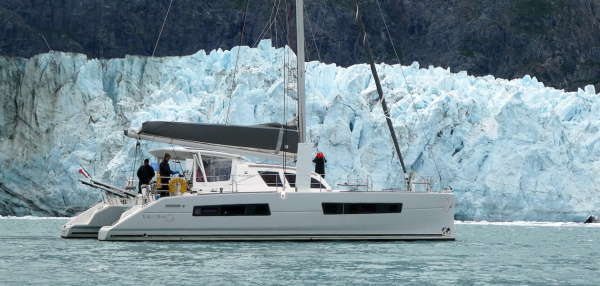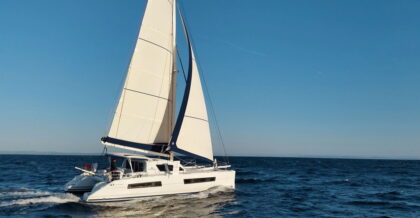Catana is based in the Catalan region of southern France and is one of the pioneers of the performance cruising catamaran market. You could say that the Catana 47 is regarded as a something of a classic.
They built the 47 for many years- so this is a well proven boat, designed by Multihull specialist Christophe Barreau to replace the 471, and this catamaran has been tested many times on circumnavigations. The design benefited from continuous improvement over the years: the last version has more carbon fiber than older examples and they are produced from updated molds for the hulls and deck- the boats still have a familiar profile (the latest iteration is a bit more angular and “muscly”), with tall twin daggerboards, open helm stations aft (a Catana trademark) and a powerful rig and sail plan.
There are plenty of options in this length of boat like the Knysna 500 SE and the Nautitechs, but if you like a bit of speed the Catana 47 should be on your radar.
The boats were built for strength with the emphasis on keeping the weight down to maximise speed through the water as opposed to boats like the Elba 45 catamaran from Fountaine Pajot which is positioned more on the comfort side of things. Carbon fiber and other composites are used in high loaded areas to beef up the vinylester/polyester laminate. The structure is vacuum-bagged during construction, with the hull and deck are both cored with closed-cell foam.
The joinery inside is also built using cored laminates to keep the weight down. All in all, Catana has managed to shave off around 700 kg off the 47’s predecessor. But it´s still a comfy boat, although you are not going to get as much room on her as you would on a Fountaine Pajot or a Lagoon. But you´ll get to your destination faster.
Sailing

One benefit of those aft helms is the deck and cockpit space you get on a Catana 47. The twin aft helm stations move the sailing away from the living area, and the trademark central winches handle most of the sail lines.
The Bridle System.
There is no traveller- the main is controlled via a bridle with two sheets, which you trim on the twin winches aft that sit amidships. This takes some getting used to, but it’s a system that Catana owners swear by – it’s an excellent way to tweak your trim and the force from any accidental gybes is minimised with this set up.
High Quality Gear
The blocks, cleats, stoppers, winches are all high quality and oversized if anything. This boat gives the impression that it has been built with plenty of safety margin up its sleeves. One great feature of the 47 is that all sails can be managed from the cockpit: you don’t need to go to the mast foot for reefing.
Visibility can be a problem in the marina as the throttles are on the starboard helm only. This is similar to the Nautitechs (although this manufacturer does include throttles on both helms as an expensive option)- the solution is to come along the starboard side when docking or post someone to watch the port side.
Sailing Feel
Another advantage of those aft helms is the direct response you get and this catamaran feels quick. She accelerates fast, especially if you keep the weight off her, and she hits top speeds in the high teens. If you are the type of sailor who enjoys trimming the sails, then you will enjoy this boat, as she rewards you with bursts of speed when she’s well set up. With those dagger-boards you’ll be able to make good headway into the wind as well, with the speed up and the leeway down.
So what´s the secret? Why is she so nippy? Well, weight saving of course, but also a square-topped main and 145-percent genoa that both get the boat slipping through the water in light to moderate breezes, and a sail plan that provides plenty of reefing options for windier conditions. The Tulip-shaped bows cut nicely through the chop when you are heading upwind and they have plenty of buoyancy forward when you are heading off it. The dagger-boards give you up to 8 feet of draft, which means less leeway on a close reach. Pull them up for a 3.5-foot boards up draft and you have less drag for when you are heading on a broad reach.
Under Power
The Catana 47 comes with twin 40HP engines and you should easily hit 7 knots at 2,200 rpm. Many owners alternate the engines to save fuel- you will still be motoring along at around 6 knots with one engine at 2400 rpm, so not much less speed over ground for a big saving in fuel consumption. If you really need to get somewhere fast under power, you’ll get 9 knots out of her with both engines purring along at 3000 rpm. As with most catamarans, she’s very manoeuvrable in the marina, but as we mentioned earlier, you just need to remember the reduced visibility of those aft helms. Coming in stern first is a breeze of course.
Up Top
The saloon is well proportioned with a big sofa area wrapped around a table, a forward facing nav station to port and an aft facing galley with a “sink and a half” tucked into the port corner of the saloon. Visibility is good and the overall feel is light, bright and spacious. Compared to other more “open designs” like the Nautitech, you get relatively more room in the saloon than the cockpit. The saloon and cockpit are on different levels which, if you are used to more modern designs, takes some getting used to. Watch your head!
Down Below
There’s plenty of room down below, and it´s light and well ventilated with good headroom. Your options are to go for a 3 cabin owner’s version with a full double berth and table aft, lots of stowage space amidships and a comfortable head with a separate shower forward. Close the curved sliding door for privacy.
The port hull has a single queen berth forward and either a double or twin berths aft (convertible twin berths). There are no showers in the port hull which might not go down so well with your guests.
Polar Diagram

Summary
There’s no great revolution in the last Catana 47 design- this is a well proven performance catamaran that has evolved over the years and remains a very attractive boat in this category. The Catana Group seem to be focusing on their Bali brand in terms of development which is where the volume is.
I’d love to see an evolved 47 design that takes cues from the newer Catana 53 which has a more open feeling between the cockpit and saloon. For the moment, however, the only new boats in the Catana range are the Catana 53 and the Ocean Class which is another 50 footer with a bulkhead steering position
If you are shopping around for alternatives, you might also want to take a look at the ITA 14.99 or the Outremer 45 – there´s plenty of choice in this market niche. And if you want some serious speed in this size and have deep pockets, then read our Gunboat 48 review – it´s one of our all time favourite catamarans. Let’s just hope that Catana rediscover their roots in the performance market.
Technical Specification
| D/L | 110 |
|---|---|
| SA/D | 20 |
| Power | 2 x 40HP |
| Sail Area | 96.2 m² / 1035 ft² |
| Draft (Boards up) | 1.10m |
| Draft (Boards Down) | 2.50m |
| Displacement (Light) | 10.9 tonnes |
| Length | 14.03m |
| SA/D* | 20 |
| Max Beam | 7.64m |
Contact Katamarans
Share your details with us and we’ll be in touch to discuss further.
"*" indicates required fields












